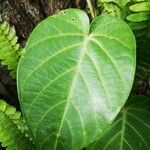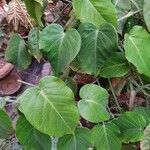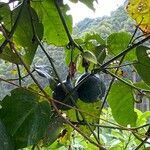A vigorous climbing vine. It grows 26 m long. It is woody at the base. The fruit is larger, yellow skinned and sweeter with larger seeds than the more common purple passionfruit. Leaves are entire, heart shaped and up to 20 cm long. Flowers are pale green. They are large. They can be 8-10 cm across. The fruit have a purple tinge and turn orange when ripe. The pulp is white or translucent and sweet. The fruit are 6-7.5 cm long.
Leaf-lamina 8–17 × 6–13 cm., broadly ovate, abruptly acuminate at apex, entire-margined, deeply cordate at the base, penninerved, membranous, dark green above, paler beneath; petiole 4–10 cm. long, bearing 4–6 scattered, liguliform or filiform glands, 3–10 mm. long; stipules 1–2·5 × 0·8–1·2 cm., ovate-lanceolate or oblong-lanceolate, acute or acuminate, entire or serrulate, narrowed at the base.
Corona in 5–7 rows, the filaments of the 2 outer ones as long as the petals, radiate, blue at apex, banded with white and reddish-purple below, the inner rows approximate, the filaments c. 2 mm. long.
Glands on petiole thread-like or long-cavate; leaves deeply cordate; flowers 6-9 cm ø, white or pale pinkish; corona filaments banded; fruits ovoid, 6-8 cm long, edible.
Bracts 2–3·5 × 1–1·5 cm., connate along 1/5–1/3 of their length, the free parts ovate or ovate-lanceolate, acute, entire, glabrous but tomentose near the margin.
Seeds c. 6 × 4 mm., narrowly obcordate, minutely tridentate at the apex, with the faces irregularly reticulate.
Operculum membranous, slightly incurved, denticulate, white and reddish-purple at margin.
Sepals 2·5–3·5 × 1–1·5 cm., acute, green outside, white inside.
Stems terete, greyish, grooved; internodes up to 8 cm. long.
Petals c. 3 × 0·8–1 cm., oblong, white or pinkish-white.
Limen cupuliform, surrounding the base of the gynophore.
Stout herbaceous glabrous plant, climbing by tendrils.
Fruit 6–8 × 4–5 cm., ovoid, yellowish or purplish.
Peduncle 2–4 cm. long, solitary or geminate.
Calyx-tube short, campanulate.
Flowers 6–9 cm. in diameter.
Tendrils stout and long.
Ovary ovoid.



